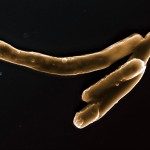Link to Pubmed [PMID] – 16520338
Mol. Biol. Evol. 2006 Jun;23(6):1129-35
The contribution of interspecies horizontal gene transfer (HGT) to the evolution and virulence of Mycobacterium tuberculosis, the agent of tuberculosis in humans, has been barely investigated. Here we have studied the evolutionary history of the M. tuberculosis Rv0986-8 virulence operon recently identified, through functional genomics approaches, as playing an important role in parasitism of host phagocytic cells. We showed that among actinobacteria, this operon is specific to the M. tuberculosis complex and to ancestral Mycobacterium prototuberculosis species. These data, together with phylogenetic reconstruction and other in silico analyses, provided strong evidence that this operon has been acquired horizontally by the ancestor of M. tuberculosis, before the recent evolutionary bottleneck that preceded the clonal-like evolution of the M. tuberculosis complex. Genomic signature profiling further suggested that the transfer was plasmid mediated and that the operon originated from a gamma-proteobacterium donor species. Our study points out for the first time the contribution of HGT to the emergence of M. tuberculosis and close relatives as major pathogens. In addition, our data underline the importance of deciphering gene transfer networks in M. tuberculosis in order to better understand the evolutionary mechanisms involved in mycobacterial virulence.


